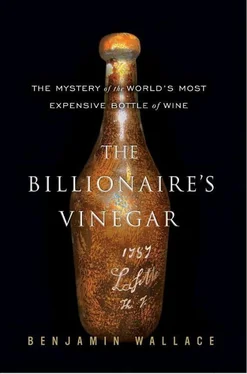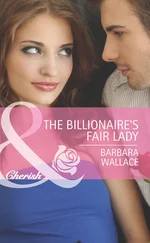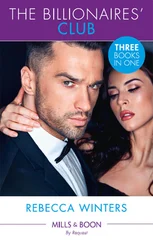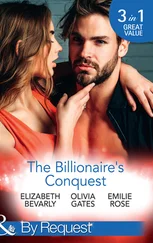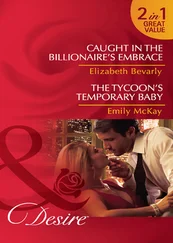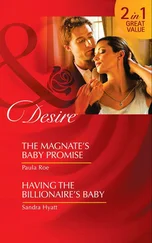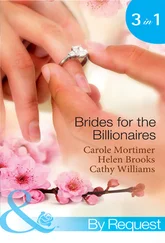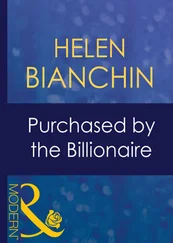As an international cash business involving commodities, with little transparency in the distribution chain, rare wine seemed ripe for exploitation by organized money launderers, and the FBI and New Scotland Yard began looking into fine-wine merchants in the United States and the UK regarding possible fake bottles. The investigators spoke of Asia as a major new target of counterfeiters; while parts of the continent, especially Singapore and Hong Kong, were home to serious connoisseurs, many new-money collectors were naïve (Pétrus and Coke being a popular combination). Soon after his “In Vino Veritas?” essay appeared in The Wine Advocate, Robert Parker received a visit from two FBI agents; he spent a day with them, giving a tutorial in the wine business. “They led me to believe it was pretty serious and widespread,” Parker recalled, “and that the Russian Mafia was involved. The question was, ‘How do you prove it?’”
IN 1997, a year after the secret anti-counterfeiting meeting in London, Sotheby’s was presented with a fitting opportunity to demonstrate its commitment to sound provenance. A handful of other Jefferson bottles had surfaced, and Sotheby’s announced that it would sell them. Though they didn’t come from Rodenstock, and had a much different history, the bottles were a remarkable thing for the auction house to offer. Serena Sutcliffe had very publicly spoken of the rising problem of fake wine, and the three Jefferson bottles sold by Christie’s, though she didn’t say so publicly, were Exhibit A when it came to suspect old vintages.
While the seller remained anonymous—Sotheby’s listed the lot of three Madeiras as “Property of a Nobleman”—the bottles seemed to have a very clear and convincing chain of ownership. Each bore a paper slip label attesting to its origin. All were Madeiras dating back to 1800, and as the auction catalog laid it out, they had been “purchased at sale of effects; President Jefferson; by Honl. Philip Evan Thomas of Maryland 1843.” The labels showed the succession of owners through whom the bottles were then passed down, ending with their purchase by Douglas H. Thomas in 1890. The consignor was Thomas’s great-grandson.
As Madeiras, these bottles stood a greater chance of being drinkable than eighteenth-century Bordeaux, but their conditions varied significantly. One was empty; Sotheby’s estimated it would fetch between $2,500 and $3,500. One was less than half-full, its contents brown and cloudy; this was estimated at $6,000 to $8,000. The bottle in the best condition, with ullage at mid-to-low shoulder, was estimated to fetch between $10,000 and $15,000. Nonetheless, the catalog cautioned warily that all of the bottles were being “sold on the basis of their historical relevance only and purchasers should assume that the wine is not fit for consumption.”
“These bottles, once belonging to President Thomas Jefferson, have miraculously survived being passed through generations and are of extraordinary historical importance,” Sotheby’s enthused. Beyond the slip labels, there were contemporaneous documents to back them up: an 1890 auction catalog mentioning the bottles as part of a sale of the estate of the daughter of Philip Evan Thomas, and an October 11, 1904, Baltimore Sun article recounting a dinner at which Douglas H. Thomas had made a toast with the Madeira. The dinner, which featured “crab flakes, Belvedere, in chafing dish” and “fancy ices,” had wrapped up with the “Jefferson Madeira Vintage, 1800.” The Sun article, from ninety-three years before, laid out the wine’s pedigree exactly as the tattered slip labels did. The provenance seemed solid. Sotheby’s saw no reason to contact Monticello to obtain a second opinion.
At the auction, on Friday, May 16, 1997, the bottle estimated at $10,000–$15,000 sold for $23,000. The winning telephone bidder was Barrie Larvin, wine director at the Rio Suite Hotel & Casino in Las Vegas, who oversaw a $6-million collection of some 100,000 bottles, including an assortment of Yquem worth $1 million. The year before, Larvin had shown a penchant for attention-getting bids when he bought a couple of Nebuchadnezzars of 1985 and 1989 Mouton for $33,350 each, and the following year he would place a winning bid of $20,000 for a 27-liter bottle of Dry Creek Vineyard 1995 Reserve Merlot, the largest bottle in the world. Now Larvin announced that he would open the Jefferson Madeira that July 4 or wait until the Millennium and sell sips for $100 each. Larvin also bought the empty Jefferson Madeira bottle for $6,000 as something to possibly offer in the casino’s gift shop. In 1999 Wine Spectator identified these bottles, without qualification, as having “once belonged to President Thomas Jefferson.”
As promised, Larvin offered tastes of the Jefferson Madeira on the New Year’s Eve of the Millennium, though for $2,500 a pour rather than $100 a taste. When he was halfway through opening it, though, the cork crumbled, and he aborted the mission. Three days later, while in the casino cellar with a winemaker visiting from Australia, Larvin decided on the spur of the moment to open the bottle with a corkscrew.
He poured a small amount into a glass, then sealed the remainder in an airtight decanter. The wine had a dark amber color and smelled like Madeira. “The bouquet was extremely powerful,” the winemaker reported. “It had hints of almonds, caramel, and burnt sugar aromas all mixed seamlessly with the rich, smooth spirit. Everything in the aroma followed through to the palate, perhaps without the same intensity, but still surprisingly well. The palate was reminiscent of raisins. The characteristic acidity of Madeira seemed to have fallen away, but the spirit made it deliciously warm to finish. I couldn’t detect any fruit flavors in the wine—the palate was all about secondary bottle characteristics—as indeed one would expect after two hundred years in the bottle!”
Whether it had been in the bottle for two hundred years, however, turned out to be a question. The Sotheby’s provenance had referred to an 1843 sale of Jefferson’s effects, but the only such sale known to the experts at Monticello had occurred in 1827, the year after Jefferson’s death. Serena Sutcliffe, informed years later of Monticello’s doubts, replied that Sotheby’s “research involved our book experts who analysed the paper and the handwriting. It all tallied. We were comfortable with the origin, the glass, the bottle, the writing—it all matched. A lot of work went into it.” Later she added, “The origin of the Madeira was solid and totally satisfactory. Funny that any other theory was never mentioned at the time…. As I am sure you know, there are many ‘Jefferson scholars,’ just as there are many Rembrandt scholars! Not to mention the Jane Austen tribe.”
It was true that the community of Rembrandt scholars had been riven by controversy regarding the authenticity of certain paintings, that specialists in Jane Austen were at odds over her sexuality, and that Jefferson experts had carried on a long debate over the paternity of Sally Hemings’s children. But Sutcliffe, an auctioneer without expertise in Thomas Jefferson, was now talking about the leading center of Jefferson scholarship, Monticello, as if it were a fringe group, and treating the well-documented history of the disposition of Jefferson’s estate as if it were a matter of interpretation. Her audacity would pale, though, next to that shown by Rodenstock at his next tasting.
CHAPTER 16

THE LAST VERTICAL
FOR HIS 1996 TASTING, RODENSTOCK HAD HIRED Andrea Bocelli, the blind Neapolitan tenor, to sing; for his next, he had in mind something even grander—a weeklong extravaganza devoted to a single wine. He spent two years preparing. The invitations to his Château d’Yquem Festival, mailed eight months in advance, boasted that guests would sample more vintages of the iconic Sauternes—125, from 1784 to 1991—“than anyone else in the world—including the owner.” Two of these—the 1784 and the 1787—would be Jefferson bottles. The event, at Munich’s Königshof Hotel, began on Sunday, August 30, 1998, and lasted seven days. When not drinking Rodenstock’s wines, from the Rodenstock-designed Riedel Sauternes glass, guests could smoke his cigars; the wine dealer, now fifty-six, had recently launched a signature Hardy Rodenstock line of Robustos and Churchills, rolled in the Dominican Republic and marketed by a Hamburg manufacturer of high-end wine closets.
Читать дальше
